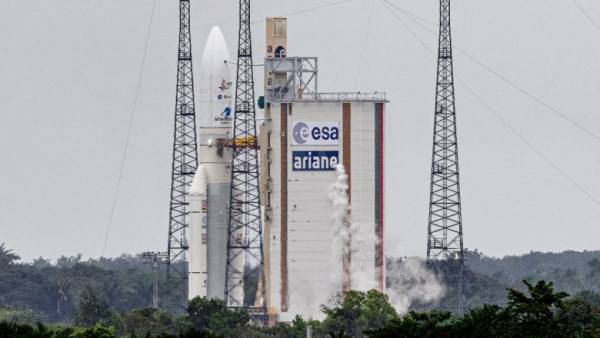
PARIS, December 25. /tass/. The Ariane 5 rocket with the James Webb orbital telescope launched on Saturday from the Kourou cosmodrome in French Guiana. Arianespace conducts a live broadcast of the launch on its website.
The Ariane 5 rocket will take the telescope into orbit. After that, the telescope will move for four weeks to its destination at the second Lagrange point, the European Space Agency clarifies. This point is four times farther from the Earth than the Moon, at a distance of 1.5 million km on the opposite side from the Sun.
Too excited to sleep? We get it.@NASAWebb – the world’s most powerful space telescope – is set to lift off Dec. 25 at 7:20am ET (12:20 UTC). Live NASA TV coverage begins at 6am ET (11:00 UTC): https://t.co/z1RgZwQkWS#UnfoldTheUniverse pic.twitter.com/Y1c1VLraeq
— NASA (@NASA) December 25, 2021
Initially, the launch was planned for December 18, but it was postponed several times for various reasons.
Later it became known that the head part with the James Webb telescope separated from the Ariane 5.
James Webb is a joint project of the US National Aeronautics and Space Administration (NASA), ESA and Canadian Space Agency (CSA). According to the American Internet portal SpaceNews, NASA has invested $ 8.8 billion in the project, ESA – 815 million, including the cost of the rocket and launch, KKA – 165 million.
LIVE NOW: Watch @NASAWebb, the world’s most powerful space telescope, launch on a mission to #UnfoldTheUniverse.
? With its 7:20am ET (12:20 UTC) liftoff, Webb will usher in a new era of astronomy.
Have questions? Drop them below. https://t.co/GgJFxbflRO
— NASA (@NASA) December 25, 2021
The telescope, named after James Webb, the head of the Apollo program, which allowed a man to visit the Moon, is to replace the Hubble Observatory in orbit. Initially, it was assumed that this would happen in 2013, but the design work was far behind schedule. Only in November 2016, the assembly of the main segments of James Webb was completed and it was announced that specialists were now starting their ground tests. As the assistant director of NASA Thomas Zurbuken admitted, the creators of the telescope “underestimated the technological complexity” of the project.
The observatory has a mirror with a diameter of 6.5 m — the largest ever put into orbit. James Webb will study the oldest stars and galaxies in the universe that formed after the Big Bang, as well as search for potentially habitable planets. The estimated life of its operation is 10 years.
Even more interesting things about science and technology